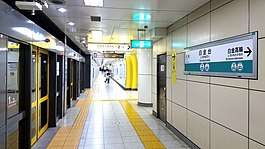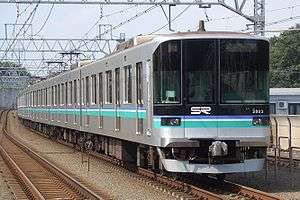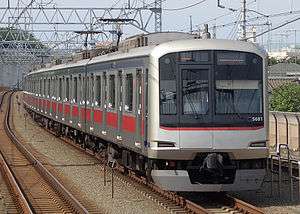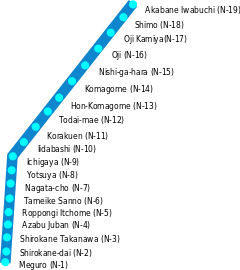Tokyo Metro Namboku Line
The Tokyo Metro Namboku Line (東京メトロ南北線, Tōkyō Metoro Namboku-sen, South-North Line) is a subway line owned and operated by Tokyo Metro in Tokyo, Japan. The line runs between Meguro in Shinagawa and Akabane-Iwabuchi in Kita. The Namboku Line was referred to as Line 7 during the planning stages, thus the seldom-used official name is Line 7 Namboku Line (7号線南北線, Nana-gō-sen Namboku-sen).
| Tokyo Metro Namboku Line | |||
|---|---|---|---|
 All stations along the Tokyo Metro Namboku Line (except the Tokyu-managed Meguro station, which use half-height platform screen doors) are fitted with full-height platform screen doors | |||
| Overview | |||
| Native name | 東京メトロ南北線 | ||
| Locale | Tokyo | ||
| Termini | Meguro Akabane-Iwabuchi | ||
| Stations | 19 | ||
| Daily ridership | 522,736 (2017)[1] | ||
| Operation | |||
| Opened | November 29, 1991 | ||
| Owner | Tokyo Metro | ||
| Depot(s) | Ōji | ||
| Rolling stock | Tokyo Metro 9000 series, Saitama Rapid Railway 2000 series, Tokyu 3000 series, Tokyu 5080 series | ||
| Technical | |||
| Line length | 21.3 km (13.2 mi) | ||
| Track gauge | 1,067 mm (3 ft 6 in) | ||
| Electrification | 1,500 V DC overhead catenary | ||
| Operating speed | 80 km/h (50 mph) | ||
| |||
On maps, diagrams and signboards, the line is shown using the color emerald N (previously coded "teal"), and its stations are given numbers using the letter "N".
Overview
Trains run through onto the Tokyu Meguro Line for Hiyoshi and the Saitama Railway's Saitama Rapid Railway Line (which is essentially a separately-owned extension of the Namboku Line) for Urawa-Misono.
The right-of-way and stations between Shirokane-Takanawa and Meguro are shared with the Toei Mita Line – a unique situation on the Tokyo subway where both operators share common infrastructure. Under an agreement between Tokyo Metro and the Tokyo Metropolitan Government, the fare for this section is calculated on the Toei fare system for passengers traveling to stations on the Mita Line past Shirokane-Takanawa, on the Metro fare system for passengers traveling to stations on the Namboku Line past Shirokane-Takanawa, and on the system "most beneficial to the passenger" (presently the Metro schedule) for travel solely on the shared sector.
On maps, diagrams and signboards, the Namboku Line is shown using the color emerald (▉), and its stations are given numbers using the letter "N".
Station list
- All stations are located in Tokyo.
- All services stop at all stations.
| Station No. |
Station | Japanese | Distance (km) | Transfers | Location | |
|---|---|---|---|---|---|---|
| Between stations |
From N-01 | |||||
| ↑ Through-running to/from Hiyoshi via MG Tokyu Meguro Line ↑ | ||||||
| N01 | Meguro | 目黒[* 1] | – | 0.0 |
|
Shinagawa |
| N02 | Shirokanedai | 白金台[* 2] | 1.3 | 1.3 | I Toei Mita Line (I-02) (shared) | Minato |
| N03 | Shirokane-takanawa | 白金高輪[* 2] | 1.0 | 2.3 | I Toei Mita Line (I-03) (shared) | |
| N04 | Azabu-juban | 麻布十番 | 1.3 | 3.6 | E Toei Oedo Line (E-22) | |
| N05 | Roppongi-itchome | 六本木一丁目 | 1.2 | 4.8 | ||
| N06 | Tameike-sanno | 溜池山王 | 0.9 | 5.7 |
|
Chiyoda |
| N07 | Nagatacho | 永田町 | 0.9 | 6.6 |
| |
| N08 | Yotsuya | 四ツ谷 | 1.3 | 7.9 |
|
Shinjuku |
| N09 | Ichigaya | 市ケ谷 | 1.0 | 8.9 |
| |
| N10 | Iidabashi | 飯田橋 | 1.1 | 10.0 |
| |
| N11 | Korakuen | 後楽園 | 1.4 | 11.4 |
|
Bunkyō |
| N12 | Todaimae | 東大前 | 1.3 | 12.7 | ||
| N13 | Hon-komagome | 本駒込 | 0.9 | 13.6 | ||
| N14 | Komagome | 駒込 | 1.4 | 15.0 | JY Yamanote Line | Toshima |
| N15 | Nishigahara | 西ケ原 | 1.4 | 16.4 | Kita | |
| N16 | Oji | 王子 | 1.0 | 17.4 |
| |
| N17 | Oji-kamiya | 王子神谷 | 1.2 | 18.6 | ||
| N18 | Shimo | 志茂 | 1.6 | 20.2 | ||
| N19 SR19 | Akabane-iwabuchi | 赤羽岩淵[* 3] | 1.1 | 21.3 | SR Saitama Rapid Railway Line | |
| ↓ Through-running to/from Urawa-Misono via the ■ Saitama Rapid Railway Line ↓ | ||||||
- Meguro is shared by Toei, Tokyo Metro, and Tokyu Corporation; Tokyu Corporation manages the station.
- Shirokanedai and Shirokane-Takanawa are shared by Toei and Tokyo Metro; Tokyo Metro manages both stations.
- Akabane-iwabuchi is shared by Tokyo Metro and Saitama Rapid Railway; Tokyo Metro manages the station.
Rolling stock
- Tokyo Metro 9000 series 6-car EMUs
- Saitama Rapid Railway 2000 series 6-car EMUs
- Tokyu 3000 series 6-car EMUs
- Tokyu 5080 series 6-car EMUs
- Tokyu 3020 series 6-car EMUs
 Tokyo Metro 9000 series
Tokyo Metro 9000 series Saitama Rapid Railway 2000 series
Saitama Rapid Railway 2000 series Tokyu 3000 series
Tokyu 3000 series Tokyu 5080 series
Tokyu 5080 series Tokyu 3020 series
Tokyu 3020 series
History
The 21.3 km Namboku Line is one of Tokyo Metro's newer lines, featuring advanced technology including full automatic train operation and platform screen doors. Although the line was originally proposed in 1968, construction did not begin until the 1980s, partly due to the right-of-way to Meguro with the Toei Mita Line. The first segment from Komagome to Akabane-Iwabuchi opened on November 29, 1991.
The line initially operated with four-car EMUs. Upon its extension to Yotsuya in March 1996, the formations were extended to six cars. All stations have enough clearance for extending to eight-car trains, but this length is not yet constructed to full. There is new news that the Namboku line will start operating 8 car trains in fiscal year 2022.
The extension to Tameike-Sannō was completed in September 1997, and the last stretch from Tameike-Sanno to Meguro was completed on September 26, 2000, when through service to the Tokyu Meguro Line started. Through service with the Saitama Rapid Railway Line commenced when it opened in March 2001 and accommodated traffic to and from Saitama Stadium during the 2002 World Cup. Although the Saitama Line is more or less a northern extension of the Namboku Line, it nevertheless remains a private entity to which the Namboku Line offers through services with.
References
- Shaw, Dennis and Morioka, Hisashi, "Tokyo Subways", published 1992 by Hoikusha Publishing
- Tokyo Metro station ridership in 2017 Train Media (sourced from Tokyo Metro) Retrieved July 23, 2018.
External links
| Wikimedia Commons has media related to Tokyo Metro Namboku Line. |
- Tokyo Metro website (in English)
